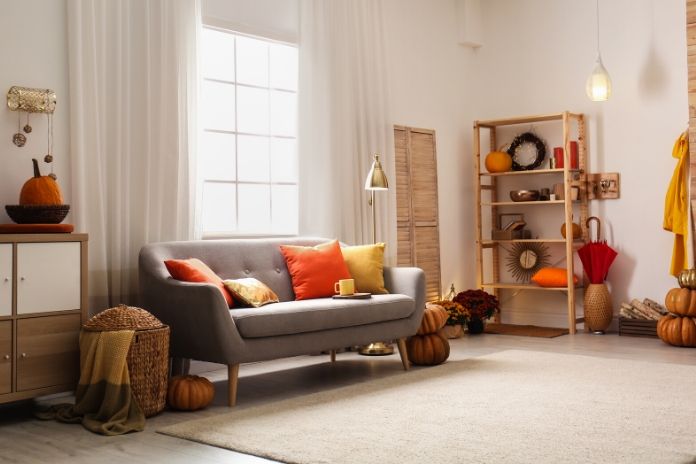Creating a cohesive furniture layout for your living room—one that’s functional as well as aesthetically appealing—can be a challenge. You know that you need a couch, a coffee table, and a few chairs, but figuring out how to arrange everything is another story. When you look at an empty room, starting from scratch and envisioning how everything will come together can seem impossible. Fortunately, there are many furniture arrangement tips to serve as guidelines throughout your interior design journey. Here are some simple tips for arranging your living room furniture to help you get started.
Choose a focal point
The first step in creating a quality living room layout is to determine a designated focal point in your room. This point should be the area around which all other furniture is directed. Common examples of living room focal points include a fireplace, television, or mantle. By arranging your furniture around a central area, you create cohesion and give the furniture in your room a sense of purpose and direction. Without a focal point, the design of your living room can quickly appear cluttered and chaotic. Every piece of furniture doesn’t have to—and shouldn’t—directly face your focal point, but they should all be turned in that general direction.
Get out your tape measure
Before you try to arrange or even purchase your furniture—especially larger items such as coffee tables, couches, and sectionals—you need to break out your trusty tape measure. To ensure that you purchase the right-size furniture, make sure to measure the dimensions of your living room. Then, draw up a floor plan on a piece of graph paper using the measurements of your room and the size of the furniture you’re considering purchasing. You could even use a computer program to create a virtual layout. Whatever method you use, creating a rough outline of your floor plan before making any purchases will ensure your furniture can fit comfortably in your living room.
Allow room for traffic flow
If you place the furniture in your living room too close together, guests won’t be able to move around freely. To avoid having to climb over couches and chairs as you navigate the room, make sure to allow for plenty of space between your furniture. You should leave at least two or three feet between your coffee table and sofa as well as between chairs. In addition, leave a clear path through your living room that allows people to enter and exit the area easily.
Create a space for conversation
A primary function of many rooms is to provide a comfortable area for conversation. People often use their living rooms as gathering spaces for socializing with other residents or mingling with company. As such, you should design the layout of your living room to allow for easy conversation. Your furniture shouldn’t all face one direction so that people must crane their necks or lean over to talk to one another. Instead, arrange furniture in a semi-circular configuration. In addition, there shouldn’t be more than eight feet of distance between seating, as this will make it difficult for people to interact with each other without raising their voices.
Use a rug to unify your setup
A great way to unify your living room furniture layout is to lay down a rug. Center a rug in the middle of the main seating arrangement to tie the room together and anchor your furniture. When you’re choosing a rug for your living room, it’s important to find the right size. A rug that’s too small can make your furniture layout feel crowded. The rug should be large enough to comfortably contain all the furniture in your seating arrangement, or at least the front legs of large pieces. Ideally, the rug should extend a few inches beyond the sofa and chairs.
Don’t place furniture against walls
A common living room furniture faux pas is to place sofas or other seating directly up against a wall. People typically do this to create more space in the center of small living areas. Doing so, however, adds little functionality to the room and typically just adds more dead space in the center of the room. Instead, allow your furniture to float a little by positioning your sofa and chairs about a foot or more away from the walls. Doing so will make your living room appear more inviting.
Include plenty of table space
A coffee table or side table should accompany every seating area in your living room. Such tables allow guests to easily access their drinks or snacks without having to get up and down, place them on the floor, or hold them the entire time they’re in the room. Place coffee and side tables at arm’s length from seating areas for optimal convenience.
Use seating to divide large rooms
If you have a larger living room or an open-concept floor plan, dividing your room into two different seating areas can be beneficial. An easy way to do so is by using the furniture itself. A large sofa, sectional, or daybed works as a perfect room divider between two different seating areas. The back of your sofa will help separate one grouping from the next, providing each group with privacy without completely blocking off each area from one another. To keep the flow between both zones, there should be a clear path between both seating areas.
To find the perfect sofa, sectional, sleeper, recliner, or chairs for your living room, take a look at the extensive array of high-quality furniture at Sofas and Sectionals. In addition to a wide variety of stunning furniture options, we also provide the option for custom-designed furniture with 10 free swatches to help you determine your ideal fabric. If you need a little extra guidance while creating your perfect living room, we also offer free design services to help you through every step of the design process. To begin your journey toward the perfect living room, contact us today.


